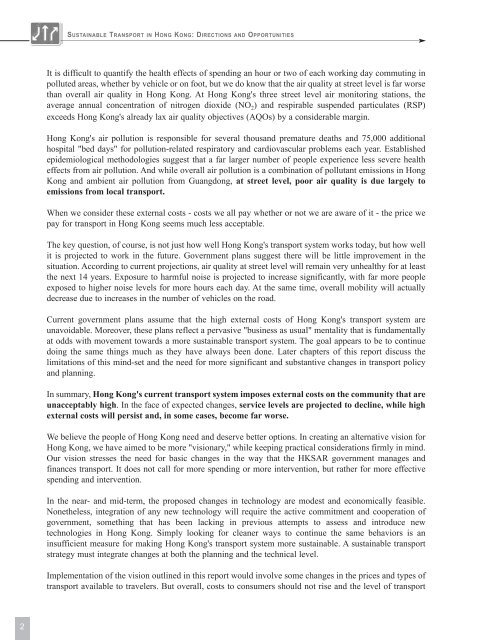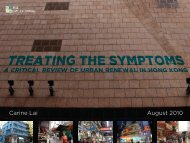Untitled - Civic Exchange
Untitled - Civic Exchange
Untitled - Civic Exchange
Create successful ePaper yourself
Turn your PDF publications into a flip-book with our unique Google optimized e-Paper software.
SUSTAINABLE TRANSPORT IN HONG KONG: DIRECTIONS AND OPPORTUNITIES<br />
It is difficult to quantify the health effects of spending an hour or two of each working day commuting in<br />
polluted areas, whether by vehicle or on foot, but we do know that the air quality at street level is far worse<br />
than overall air quality in Hong Kong. At Hong Kong's three street level air monitoring stations, the<br />
average annual concentration of nitrogen dioxide (NO 2 ) and respirable suspended particulates (RSP)<br />
exceeds Hong Kong's already lax air quality objectives (AQOs) by a considerable margin.<br />
Hong Kong's air pollution is responsible for several thousand premature deaths and 75,000 additional<br />
hospital "bed days" for pollution-related respiratory and cardiovascular problems each year. Established<br />
epidemiological methodologies suggest that a far larger number of people experience less severe health<br />
effects from air pollution. And while overall air pollution is a combination of pollutant emissions in Hong<br />
Kong and ambient air pollution from Guangdong, at street level, poor air quality is due largely to<br />
emissions from local transport.<br />
When we consider these external costs - costs we all pay whether or not we are aware of it - the price we<br />
pay for transport in Hong Kong seems much less acceptable.<br />
The key question, of course, is not just how well Hong Kong's transport system works today, but how well<br />
it is projected to work in the future. Government plans suggest there will be little improvement in the<br />
situation. According to current projections, air quality at street level will remain very unhealthy for at least<br />
the next 14 years. Exposure to harmful noise is projected to increase significantly, with far more people<br />
exposed to higher noise levels for more hours each day. At the same time, overall mobility will actually<br />
decrease due to increases in the number of vehicles on the road.<br />
Current government plans assume that the high external costs of Hong Kong's transport system are<br />
unavoidable. Moreover, these plans reflect a pervasive "business as usual" mentality that is fundamentally<br />
at odds with movement towards a more sustainable transport system. The goal appears to be to continue<br />
doing the same things much as they have always been done. Later chapters of this report discuss the<br />
limitations of this mind-set and the need for more significant and substantive changes in transport policy<br />
and planning.<br />
In summary, Hong Kong's current transport system imposes external costs on the community that are<br />
unacceptably high. In the face of expected changes, service levels are projected to decline, while high<br />
external costs will persist and, in some cases, become far worse.<br />
We believe the people of Hong Kong need and deserve better options. In creating an alternative vision for<br />
Hong Kong, we have aimed to be more "visionary," while keeping practical considerations firmly in mind.<br />
Our vision stresses the need for basic changes in the way that the HKSAR government manages and<br />
finances transport. It does not call for more spending or more intervention, but rather for more effective<br />
spending and intervention.<br />
In the near- and mid-term, the proposed changes in technology are modest and economically feasible.<br />
Nonetheless, integration of any new technology will require the active commitment and cooperation of<br />
government, something that has been lacking in previous attempts to assess and introduce new<br />
technologies in Hong Kong. Simply looking for cleaner ways to continue the same behaviors is an<br />
insufficient measure for making Hong Kong's transport system more sustainable. A sustainable transport<br />
strategy must integrate changes at both the planning and the technical level.<br />
Implementation of the vision outlined in this report would involve some changes in the prices and types of<br />
transport available to travelers. But overall, costs to consumers should not rise and the level of transport<br />
2

















